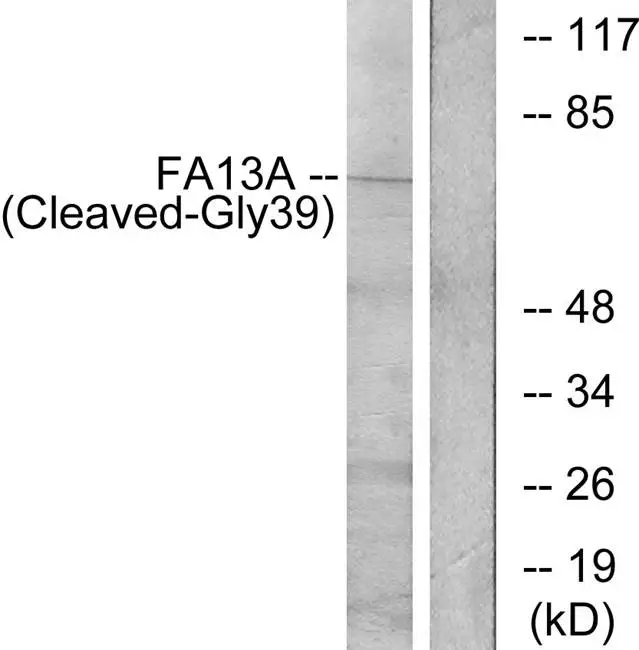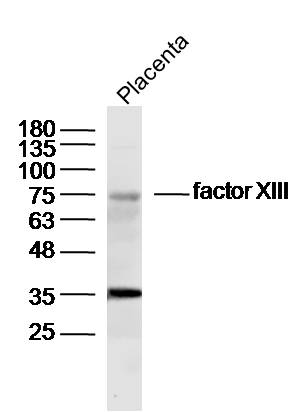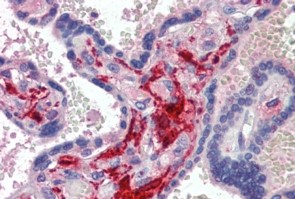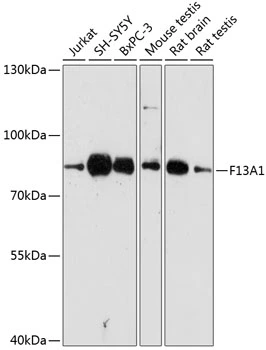
WB analysis of Jurkat cells treated with etoposide 25uM (24h) lysate using GTX86889 Factor XIIIa (cleaved Gly39) antibody. The lane on the right is blocked with the synthesized peptide.
Factor XIIIa (cleaved Gly39) antibody
GTX86889
ApplicationsWestern Blot
Product group Antibodies
TargetF13A1
Overview
- SupplierGeneTex
- Product NameFactor XIIIa (cleaved Gly39) antibody
- Delivery Days Customer9
- Application Supplier NoteWB: 1:500~1:1000. *Optimal dilutions/concentrations should be determined by the researcher.Not tested in other applications.
- ApplicationsWestern Blot
- CertificationResearch Use Only
- ClonalityPolyclonal
- ConjugateUnconjugated
- Gene ID2162
- Target nameF13A1
- Target descriptioncoagulation factor XIII A chain
- Target synonymsF13A, coagulation factor XIII A chain, FSF, A subunit, TGase, bA525O21.1 (coagulation factor XIII, A1 polypeptide), coagulation factor XIII, A polypeptide, coagulation factor XIII, A1 polypeptide, coagulation factor XIIIa, factor XIIIa, fibrin stabilizing factor, A subunit, fibrinoligase, protein-glutamine gamma-glutamyltransferase A chain, transglutaminase A chain, transglutaminase. plasma
- HostRabbit
- IsotypeIgG
- Protein IDP00488
- Protein NameCoagulation factor XIII A chain
- Scientific DescriptionThis gene encodes the coagulation factor XIII A subunit. Coagulation factor XIII is the last zymogen to become activated in the blood coagulation cascade. Plasma factor XIII is a heterotetramer composed of 2 A subunits and 2 B subunits. The A subunits have catalytic function, and the B subunits do not have enzymatic activity and may serve as plasma carrier molecules. Platelet factor XIII is comprised only of 2 A subunits, which are identical to those of plasma origin. Upon cleavage of the activation peptide by thrombin and in the presence of calcium ion, the plasma factor XIII dissociates its B subunits and yields the same active enzyme, factor XIIIa, as platelet factor XIII. This enzyme acts as a transglutaminase to catalyze the formation of gamma-glutamyl-epsilon-lysine crosslinking between fibrin molecules, thus stabilizing the fibrin clot. It also crosslinks alpha-2-plasmin inhibitor, or fibronectin, to the alpha chains of fibrin. Factor XIII deficiency is classified into two categories: type I deficiency, characterized by the lack of both the A and B subunits; and type II deficiency, characterized by the lack of the A subunit alone. These defects can result in a lifelong bleeding tendency, defective wound healing, and habitual abortion. [provided by RefSeq, Jul 2008]
- Storage Instruction-20°C or -80°C,2°C to 8°C
- UNSPSC12352203






![IHC-P analysis of human placenta using GTX01879 Factor XIIIa antibody [E980.1]. The target signal localized in the Hofbauer cells of the placental villi.](https://www.genetex.com/upload/website/prouct_img/normal/GTX01879/GTX01879_20200811_IHC-P_90_w_23053121_652.webp)
